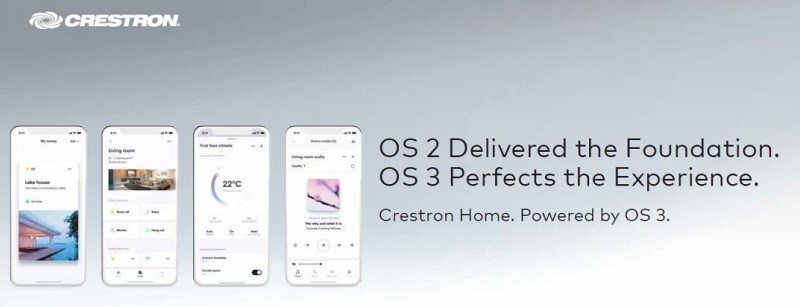Crestron Home OS3
Goodbye Pyng, Hello Crestron Home OS 3
Julie Jacobson · January 30, 2019
Crestron is killing Pyng. Not the home-automation products or cloud-based platform developed over the past five years. Just the Pyng brand and messaging.
At ISE 2019, Crestron will formally announce “Crestron Home” OS 3 as the successor to Pyng OS 2. There’s no more Pyng vs. Crestron for the residential mid-market. It’s just Crestron. Crestron Home.
Much of the smart-home industry still thinks of Pyng as “Crestron Lite,” recalling its launch at CEDIA 2014 as a relatively limited offering for mainstream residential applications.
OS 2 delivered the foundation; OS 3 perfects the experience. Crestron Home, powered by OS 3, delivers a stunning new high-performance user interface for mobile devices and Crestron TSW touch screens.
Pyng today is a beast. OS 2 launched last year with much-awaited support for DigitalMedia, and the platform now supports up to 150 lighting loads, 60 keypads, 32 zones of audio, 12 zones of video, 24 HVAC zones and 40 motorized shades.
As Crestron intended all along (more below), Pyng has evolved to become the foundation of the company’s residential portfolio.
“There is still a perception of it being a small system,” says John Clancy, Crestron VP, Residential, in an interview with CE Pro. "The suggestion that this is a little kid’s version of Crestron has to go away.”
The same ease of programming that Crestron introduced with its earliest Pyng system now applies to highly complex whole-house control systems.
NEW! Crestron ‘Perfects’ 1GB, Bows First DM NVX for Residential
“You can knock out a very complicated system with almost no programming at all – just an iPad or a Web app,” Clancy says. “There’s no special software and you don’t need tons of experience and training. We’ve sold thousands of these, and dealers are knocking them out with a technician.”
If you don’t believe it, visit Crestron’s Deployment Zone at ISE, where dealers can participate in a Pyng programming competition.
“In just a few minutes, they’ll teach you how to do OS 2,” Clancy says, “and then hand you an iPad and time you.”
Clancy estimates the winning times to be around five minutes to complete three rooms with shades, lighting, audio and video.
Crestron Home OS 3
The metamorphosis from Pyng to Crestron is nearly complete with OS 2. There’s just one thing left before Pyng leaves the nest: an entirely new user interface and customer experience.
OS 3 delivers exactly that.
Introducing Crestron Home powered by OS3 from Crestron Electronics.
At ISE, we will see a brand new look and feel for the platform formerly known as Pyng. Crestron waited to re-engineer the UX until it had refined all the back-end machinery and enabled all the key integrations … which it did in OS 2, especially with support for “the big one,” DigitalMedia.
“OS 2 really focused on rebuilding the back end, making it easy to get [Pyng] deployed, and supporting bigger systems,” Clancy says. “OS 3 is really about the front end for the customer.”
In addition to a “dramatically redesigned” UI, Crestron added a number of tools for homeowners:
Multi-Home Support
The Pyng platform used to support just one system at a time. If you had two homes, you had two completely separate systems and apps.
OS 3 brings multi-system support so, “as an end user I can bounce between multiple homes when I’m on the road,” Clancy says.
User Management
Not today, but soon, end users will have the ability to manage access to their Pyng systems.
For instance, the end user will be able to lock a dealer out of the system and only authorize access with permission.
Also, homeowners can manage access among family members and other users, Clancy explains: “My kids may not have the same rights as I have. For example, they can’t do anything that affects my bedroom.

More User Customization
Pyng for the first time brought Crestron users a new level of self-customization, eliminating the need to call a dealer for every little system change.
OS 3 empowers the user even further. Many configuration options that were not available in Pyng will be exposed to customers in Crestron Home. For example, users can create house scenes and room scenes, and illustrate those scenes however they like, perhaps a photo of the space.
They can alter climate, lighting and settings by themselves … or provide access to dealers for a select period of time if they need some help.
Powerful Processor
To support and enhance the new Crestron Home functionality, the company will be launching a more powerful processor in the spring that Clancy says is two times more powerful than the latest Pyng 2 controller.
The Evolution and Significance of Pyng: A Skunkworks Project
When Crestron introduced Pyng at CEDIA Expo 2014, we headlined the big news:
Crestron Goes Mainstream with User-Configurable $599 Pyng Home Automation Platform
Crestron, the king of expensive home automation, launches Pyng at CEDIA 2014
Cloud-enabled platform kills pricey programming, lets users configure themselves.
So exciting was the announcement we nearly added party emojis and exclamation points to the headline, but decorum prevailed.
With Pyng, Crestron dealers could now sell relatively modest home-control systems to a broader customer base because an entry-level tech could configure a system lickety split, right at the customer premises. The Pyng jobs wouldn’t carry the overhead of specially trained programmers writing custom code, along with proud graphic designers perfecting every last icon.
Crestron would now be accessible to otherwise dismissive customers who just wanted a good and reliable home automation system, without the bells and whistles, and without the pain – to pocketbook or patience.
The risk to customers was nominal. The system could be installed relatively quickly and painlessly for any supported devices (lighting, thermostats, security and shades for starters), and then ported over to a full-blown Crestron system if desired.
The especially exciting development was that consumers themselves could make little changes to their Pyng system – like scheduling lights to come on – without having to call the installer. Although such “customer empowerment” was nothing new for the industry, it was still a triumph for Crestron, its dealers, and their customers, some 45 years in the making.
The triumph, however, seemed to be lost on most Crestron dealers, who were skeptical at best and suspicious at worst. They applauded politely while muttering “Blasphemers!” and “DIY!” and other hurtful epithets.
Dealer response to Pyng was pretty tepid in the early days and for quite some time.
Crestron conceded early on that dealers didn’t seem to “get” Pyng, which was pretty obvious from our discussions with them. “We only do custom, higher end jobs. It’s not for us,” dealers would tell us … before acknowledging they had no idea what it actually did, because, “It’s not for us.”
In fact, it would have been valuable for most Crestron dealers on most jobs: Entry-level technicians could at least rush through the commissioning, configuration and installation of Pyng-supported devices in the earliest phase of a project -- quickly and painlessly for both dealer and client.
The job might end there … or a skilled programmer might port the settings into a full-blown Crestron system by simply flipping a switch, and praying to the Pyng spirits for continued relief from jobsite tedium.
As far as we know, no one rushed out to create new business models around “Crestron Lite.” It seems a good chunk of dealers largely ignored the platform, telling reps to come back when Pyng supported DM, the most successful product line in Crestron’s history.
Crestron continued to invite new partners to the Pyng fling, adding multiroom audio systems, smart TVs, all the popular voice assistants and TV streamers, plus new services and features like channel presets … all enabled by Crestron’s first comprehensive cloud service built from the ground up for this entirely new platform (and paradigm).
Herein lies the significance of Pyng: It was a skunkworks project, developed separately but simultaneously with other Crestron platforms. Crestron employed a crew of IoT developers who weren’t encumbered by industry norms or legacy architectures.
Pyng was essentially built from scratch – and at great expense – as a cloud-driven platform that would be the “ideal” for modern-day integrators and consumers.
Crestron didn’t want to tweak the great platform it already had. It wanted to start all over with: “If we were to build the greatest home-integration platform today, what would it look like?”
It looked like Pyng in 2014. Today, the answer is Crestron Home.
Big Developments on Crestron Custom, too!
Despite the energy around Crestron Home, the company wants to be perfectly clear about one thing: Crestron is not abandoning the super-custom market that defines its legacy.
In fact, Crestron continues to invest heavily in its flagship 3-Series control suite, launching this year a standards-based HTML 5 programming environment. It’s a big deal – perhaps overdue, but still a huge win for the vast community of Crestron partners and, ultimately, end users.
About the Author
Julie Jacobson
Founder, Editor-at-Large at CEPro




